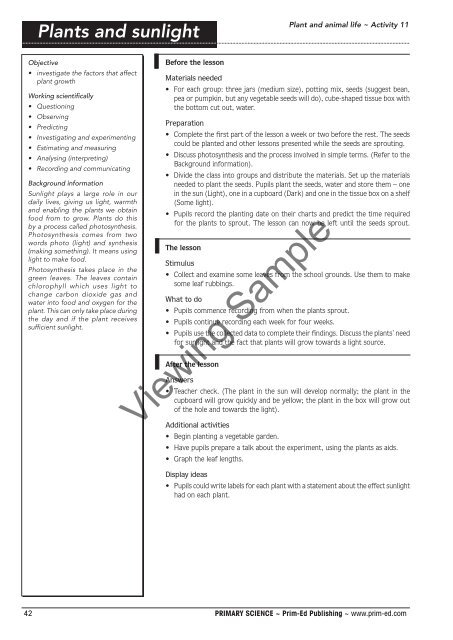PR-0553UK Primary Science - Book 3
Create successful ePaper yourself
Turn your PDF publications into a flip-book with our unique Google optimized e-Paper software.
Plants and sunlight<br />
Plant and animal life ~ Activity 11<br />
Objective<br />
• investigate the factors that affect<br />
plant growth<br />
Working scientifically<br />
• Questioning<br />
• Observing<br />
• Predicting<br />
• Investigating and experimenting<br />
• Estimating and measuring<br />
• Analysing (interpreting)<br />
• Recording and communicating<br />
Background information<br />
Sunlight plays a large role in our<br />
daily lives, giving us light, warmth<br />
and enabling the plants we obtain<br />
food from to grow. Plants do this<br />
by a process called photosynthesis.<br />
Photosynthesis comes from two<br />
words photo (light) and synthesis<br />
(making something). It means using<br />
light to make food.<br />
Photosynthesis takes place in the<br />
green leaves. The leaves contain<br />
chlorophyll which uses light to<br />
change carbon dioxide gas and<br />
water into food and oxygen for the<br />
plant. This can only take place during<br />
the day and if the plant receives<br />
sufficient sunlight.<br />
Before the lesson<br />
Materials needed<br />
• For each group: three jars (medium size), potting mix, seeds (suggest bean,<br />
pea or pumpkin, but any vegetable seeds will do), cube-shaped tissue box with<br />
the bottom cut out, water.<br />
Preparation<br />
• Complete the first part of the lesson a week or two before the rest. The seeds<br />
could be planted and other lessons presented while the seeds are sprouting.<br />
• Discuss photosynthesis and the process involved in simple terms. (Refer to the<br />
Background information).<br />
• Divide the class into groups and distribute the materials. Set up the materials<br />
needed to plant the seeds. Pupils plant the seeds, water and store them – one<br />
in the sun (Light), one in a cupboard (Dark) and one in the tissue box on a shelf<br />
(Some light).<br />
• Pupils record the planting date on their charts and predict the time required<br />
for the plants to sprout. The lesson can now be left until the seeds sprout.<br />
The lesson<br />
Stimulus<br />
• Collect and examine some leaves from the school grounds. Use them to make<br />
some leaf rubbings.<br />
What to do<br />
• Pupils commence recording from when the plants sprout.<br />
• Pupils continue recording each week for four weeks.<br />
• Pupils use the collected data to complete their findings. Discuss the plants’ need<br />
for sunlight and the fact that plants will grow towards a light source.<br />
After the lesson<br />
Answers<br />
• Teacher check. (The plant in the sun will develop normally; the plant in the<br />
cupboard will grow quickly and be yellow; the plant in the box will grow out<br />
of the hole and towards the light).<br />
Viewing Sample<br />
Additional activities<br />
• Begin planting a vegetable garden.<br />
• Have pupils prepare a talk about the experiment, using the plants as aids.<br />
• Graph the leaf lengths.<br />
Display ideas<br />
• Pupils could write labels for each plant with a statement about the effect sunlight<br />
had on each plant.<br />
42 <strong>PR</strong>IMARY SCIENCE ~ Prim-Ed Publishing ~ www.prim-ed.com


















